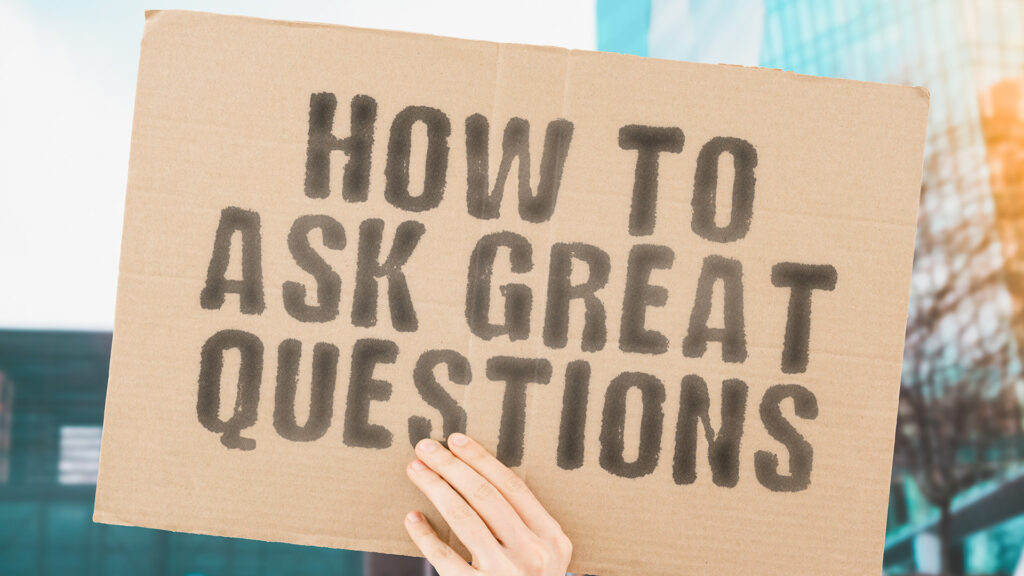Let’s start by identifying what a “Good” customer question is… A “Good” question is effective at getting information that helps steer the conversation where you want it to go and also shows the recipient that you understand them and/or their goals/challenges.
A few weeks back our firm was in the process of selecting a new vendor for an expansion piece of tech as a part of our training capabilities. While we were vetting who we wanted, I had several calls set with companies to find who would best fit our needs.
As I began to take these preliminary calls, it amazed but did not surprise me when I noticed that each of these company’s sales professionals had only one agenda item: Sell me their product. Not understand my goals, not understand the challenges I’m trying to solve, nope…just sell me the product. So, they almost all went straight into data dump mode right after they created “rapport” with me.
Now you may say “Jeff, obviously they did that, that is the goal.” Then I would say to you, “it’s a shame you feel that way.” The goal of any initial client call should be to determine what objectives and challenges the customer is having so they can make an educated decision on if the solution you have is a fit for what they are trying to solve and if moving forward makes sense. The only way you can determine this with any effectiveness is to understand how to ask “Good” questions.
When you take the time to learn how to ask a good, effective question you gain the following:
- Connection
- Credibility
- Trust
- Information
- Undivided Attention
Not only do you gain those items, but you have now earned the right to ask another insightful question. You have now moved from a presentation about you, to a conversation about them.
Have you ever been on a call with a client or colleague and they said, “Wow, that’s a good question” and then paused for a minute to answer you correctly and intelligently? It feels good, right? When someone acknowledges that the question you posed was asked at the right time, in the right way, and with the right intent, it gains points in all 5 categories listed above.
So how do you make sure you ask as many of these types of questions as possible? What I know to be true is that asking good questions takes practice. If you know someone excellent at asking questions, I guarantee that they have practiced and studied their craft so they can perform during those “moments of impact”, like a customer conversation. Being great at asking “Good” questions is not just something that magically happens. Asking good questions is almost similar to the old definition of luck: When opportunity and preparedness meet. That is the intersection where good and effective questions could and should live.
As we discussed, the art of effective questions comes from learning about the prospect’s feelings around their objectives/challenge areas and creating questions that drive ownership of the problems by the prospect and an urgency to do something about it. When this is done well, they perform and reach their goals. Here are a few tips to help you with your questioning:
- Stop asking Self Centered Leading Questions that you should already know the answer too: “So, tell me about your company?”
- Very few things increase change resistance in clients like stupid questions or obvious answer questions: “How would your business change if you could make more money?”
- Sometimes it’s more important to understand the questions not to ask, instead of being so concerned with the questions to ask: Remember you don’t want to ask simple, self-serving questions that will make the customers’ guard go up. These are typically questions that are “pain point” focused: “What would happen if your assembly line came to a halt?” Trust must be established first and these questions do the opposite. They spike cortisol (stress chemical) and increase change resistance.
- Industry expertise and hot buttons only show your knowledge of their business, however a well crafted question shows value and understanding of them and their role. Big difference!
- Finally, prepare questions in advance of your calls. You should have a list of at least 5 good questions that will help steer your conversation. These should be open-ended questions with words like Who, What, Where, Why, and How at the beginning. That being said, make sure all 5 questions don’t start with “What or How”. Keep it interesting by asking “Which or When” questions as well. There is a scientific reason for it!
For example: “When you think back about this blog, what are the 2-3 things you are now going to implement to impact your future conversations?” How about that for a question? See what I did there. Questions can be fun, especially if you work on them.
At Braintrust, as a part of our NeuroCoaching™ Program, we have created a subset course called NeuroQuestioning™ based on the demand of our clients wanting to learn the science of asking “good” questions. In NeuroQuestioning™ we teach the science of how the brain responds to questions and how to make sure the questions you are asking have purpose, power, and impact.





